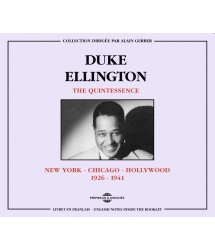It is inevitable that there should be varied opinions about the choice of 36 Ellington selections from 1926 to 1941 : the compiler himself hints that another complete list of titles could easily have been chosen. In the main the pieces have been selected logically and with taste. Personal predilections must intrude and in this respect it would have been pleasing to have barney’s concerto – the natural complement to Cootie’s Concerto from the same date (1936) included). More serious, however, is the « splitting » of the new Black And Tan Fantasy of 1938. Parts 1 & 2 constitute one of the most masterful of Ellington re-crreations and to omit Part 1 is musical sacrilege (perhaps the compiler Alain Gerber had no say in this strange deletion). In all cases, Frémeaux & Associés must be complimented on the quality of transferts. The musics rings bright and clear ; sometimes a little treble filtering is required but this only emphasises the brightness and sharp quality of frequency spectrum presented. The three ‘non-Ellington’ selections are well chosen. It is good to have the Miley stimulated Yellow dog Blues, the Hodges inspired Moonglow and the rich flow of Chloe. Monsieur Gerber has a liking for Whestol and thoughtfully includes Awful Sad, Misty Mornin’ and the 1930 Mood Indigo. Tracks are well chosen to present the great soloist – Cootie (two concertos), Rex, nance, Hodges, Bigard, Webster, Tricky and brown yet one has a slight regret that there is no feature for Tizol (Caravan or Conga Brava ?). The two ‘extended’ works sound well. Despite the occasional hint of ensemble faltering the first Diminuendo And Crescendo In Blue is the finest in its sense of integration and progression. Why Duke became obsessed with finding a link passage for this work remains a mystery ; certainly the near hysterical performance at Newport (1956) gave the band much needed publicity but it denigrated a fine work. Reminiscing In Tempo flows without interruption – the producer has the sense to realize that the end of a 78rpm side was not a musical pause. The beauty of this strangely mediative work glows more with every playing. Why it was first subject to adverse criticism of such extreme virulence is now beyond comprehension. A recommended survey of the period involved.
Vic BELLERBY – JAZZ JOURNAL INTERNATIONAL
Vic BELLERBY – JAZZ JOURNAL INTERNATIONAL











